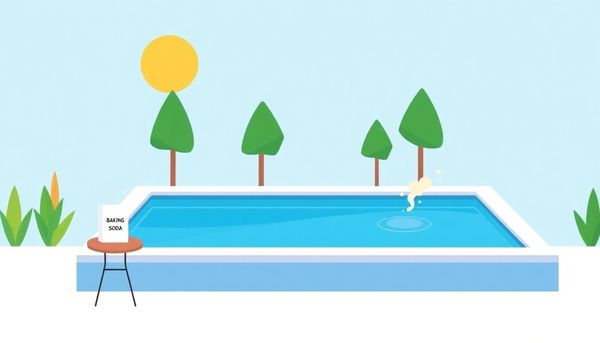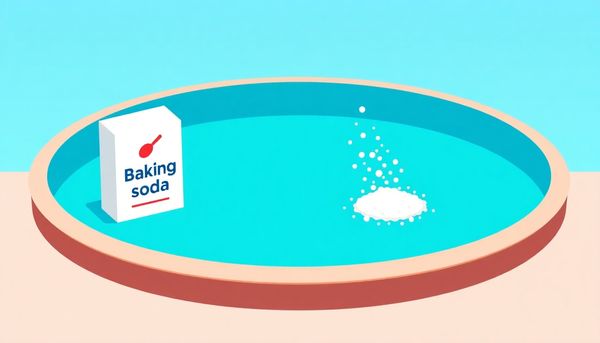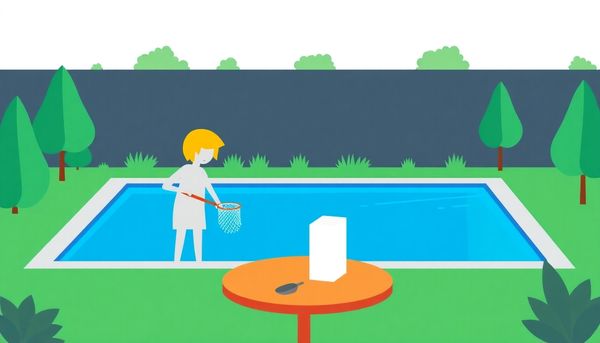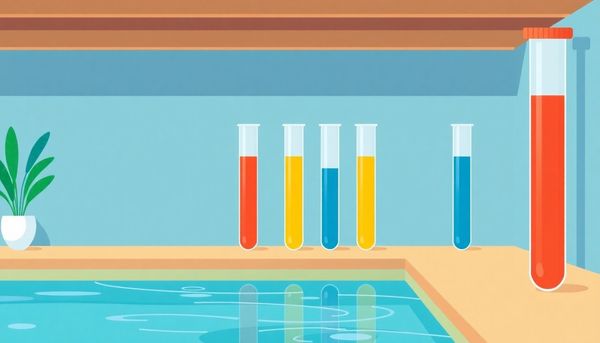Transform Your Pool with Baking Soda: Easy Alkalinity Tips
June 24th, 2024
June 24th, 2024
Swirling, crystal-clear waters can transform any backyard into a personal oasis, but maintaining that pristine aquamarine hue requires more than just an occasional skim with a net. Among the more subtle aspects of pool care is the science of water chemistry, particularly the often overlooked element of alkalinity. When the balance tips unfavorably, pool water can become a breeding ground for chaos, leading to murky waters and irritated skin. This is where a simple household staple—baking soda—enters the scene as an unlikely hero.
Many pool owners, perhaps including a neighbor or two, might recall the panic of discovering their pool’s water had taken on an unwelcome tint or caused swimmers discomfort. In such situations, a trip to the local store for a few boxes of baking soda becomes an impromptu rescue mission. It's remarkable how this humble white powder, typically reserved for baking cookies or neutralizing fridge odors, can restore balance to a pool's pH levels. By increasing the alkalinity, baking soda not only elevates the comfort for swimmers but also prolongs the lifespan of costly pool equipment.
Understanding how this alchemical transformation occurs—and how you can replicate it safely—is key to ensuring your pool remains a refreshing retreat rather than a source of frustration. With just a bit of knowledge and a sprinkle of baking soda, you can master the art of pool maintenance and keep the waters inviting all season long.

Owning a pool is a privilege, but maintaining the delicate balance of its chemistry is crucial for a sparkling, safe swim. One unsung hero in this balancing act is baking soda. Known primarily for its culinary uses, baking soda, or sodium bicarbonate, doubles as an effective solution for raising pool alkalinity. This simple household item can save you money while safeguarding your pool against the pitfalls of improper pH levels.
Monitoring the alkalinity of your pool is essential, as it acts as a buffer for the pH level, preventing drastic shifts that could damage equipment or irritate swimmers. When your pool's alkalinity dips below the ideal range of 100 to 150 ppm, baking soda steps in. Adding about 1.5 pounds (680 grams) per 10,000 gallons (37,854 liters) of water can gently elevate the alkalinity by approximately 10 ppm, stabilizing the pool's environment.
When utilizing baking soda, it's wise to distribute it evenly across the pool's surface rather than dumping it into the skimmer. This method ensures a gradual dissolution and avoids any potential complications with your pool's filtration system. With the right balance maintained, the pH typically hovers between 7.4 and 7.6, allowing for a comfortable swim free from the hazards of overly acidic or basic water.
Incorporating baking soda into your pool care routine not only streamlines maintenance but also opens up a world of versatility. Whether you're tweaking water chemistry or using it to scrub stubborn grime from tiles, this multipurpose marvel proves its worth time and again.
Using baking soda to adjust the alkalinity in your pool is a game-changer. It’s cost-effective, readily available, and simple to use. Before adding any to your water, ensure you have an accurate measurement of your pool’s volume. Once you've determined the size, you can start by using 1.5 pounds (680 grams) of baking soda for every 10,000 gallons (37,854 liters) of pool water. This typically increases the alkalinity by about 10 ppm, providing a buffer that stabilizes pH levels.
One sunny afternoon, while balancing my own pool's chemistry, I discovered a handy trick: instead of dumping it all in one spot, sprinkle the baking soda evenly across the surface. This helps it dissolve more efficiently, avoiding clumps that might cloud the water. Stir the pool gently with a pool brush to aid in dispersion. Remember, patience is key; it might take a few hours or even overnight for levels to stabilize fully.
Avoid adding baking soda through your skimmer. This mistake can lead to issues with your filtration system, especially if it interacts with other chemicals. Instead, rely on direct addition to the water itself. Monitoring the impact on alkalinity and pH ensures you don’t overshoot the mark. By maintaining alkalinity between 100 and 150 ppm and pH between 7.4 and 7.6, you will not only keep your pool pristine but also extend the lifespan of your equipment. Enjoy the refreshing clarity of a well-balanced pool!
Balancing the pH and alkalinity of your pool is akin to maintaining harmony in a finely-tuned orchestra. Each element must work in concert to ensure your pool remains a clean and inviting oasis. Alkalinity acts as the sturdy backbone, a buffer that stabilizes pH levels, preventing erratic swings that can lead to murky waters or stained surfaces. Using baking soda, a humble kitchen staple, can be a cost-effective and efficient way to boost your pool's alkalinity.
Consider this: each time rain pours into your pool or a group of energetic swimmers takes a plunge, the delicate balance of your pool’s chemistry is momentarily disrupted. With alkalinity levels set between 100 and 150 ppm, you create a shield, protecting the pH from these external influences. Imagine your alkalinity as a bodyguard for pH, taking the hit so that your pool water remains just right—between 7.4 and 7.6 on the pH scale.
To visualize the impact, sprinkling around 1.5 pounds of baking soda per 10,000 gallons of pool water gently nudges alkalinity upwards by approximately 10 ppm. But remember, moderation is key. Pouring it gradually ensures you aren't tipping the scales too far in the other direction. Just like a favorite recipe, adjusting ingredients with care ensures the final product is flawless. So next time you reach for baking soda, think beyond its role in baking and embrace it as an ally in achieving the sparkling, balanced pool of your dreams.
When it comes to adjusting your pool's alkalinity, precision and patience are your best allies. Start by checking your pool's current alkalinity level using a reliable test kit. Once you have your baseline, calculate the amount of baking soda needed—typically, 1.5 pounds per 10,000 gallons will increase alkalinity by about 10 ppm. It’s essential not to rush this process. Rather than dumping all the baking soda in at once, sprinkle it gently across the water’s surface, allowing time for it to dissolve thoroughly. Stirring the water gently with a pool brush can help with even distribution.
A personal tip: I once added too much baking soda too quickly, turning my pool into a cloudy mess. It taught me the value of gradual adjustments. After applying the baking soda, wait at least six hours, then retest the alkalinity and pH levels. This ensures the chemicals have had ample time to integrate into the water.
Remember, a stable alkalinity not only acts as a shield for your pool's pH but also supports effective chlorine function, keeping your pool both safe and inviting. If you’re unsure of your pool’s exact water volume, don’t hesitate to use a pool calculator—better to double-check than to overcorrect. With careful application and regular monitoring, your pool will maintain the perfect balance, ensuring crystal-clear water and a safe swimming environment.

Maintaining the right pH level in your pool is akin to keeping your car's engine in tune—it ensures smooth operation and prevents damage. For anyone who has experienced the havoc of acidic pool water, you know it can corrode everything from delicate tiles to robust ladders. Conversely, overly basic water is no friend either, often leaving behind a stubborn white crust on pool surfaces, much like the build-up you might find on neglected kitchen faucets.
Balancing your pool’s pH means keeping it snugly between 7.4 and 7.6 on the pH scale. This sweet spot not only preserves your pool's infrastructure but also optimizes chlorine efficiency, ensuring your pool remains a safe, inviting oasis. Here, alkalinity steps in as the unsung hero, acting as a buffer to keep pH fluctuations at bay.
You might recall a stormy afternoon when a sudden downpour threw your pool’s chemistry into disarray. That’s when alkalinity levels, ideally between 100 and 150 ppm, come to the rescue, stabilizing pH levels against such intrusions. By introducing baking soda, a common household item, you can elevate alkalinity without breaking the bank on pricey pool chemicals. A sprinkle of sodium bicarbonate often does the trick, cushioning your pool’s pH against the unpredictabilities of weather and water activity, thereby safeguarding your investment.
Balancing your pool's alkalinity might seem like a daunting task, but it’s crucial for a sparkling oasis. Alkalinity acts as a buffer for pH, protecting it from sudden changes whenever rain strikes or swimmers splash about. Just as a loyal bodyguard shields a celebrity from paparazzi, alkalinity shields your pool’s pH from drastic fluctuations. Keeping alkalinity levels steady between 100 and 150 ppm not only ensures balanced water chemistry but also prolongs the life of your pool’s surfaces and equipment.
Once upon a sunny afternoon, my friend Sam found his pool equipment crusted with white deposits. A classic case of scaling due to high alkalinity. What he learned that day was the importance of regular testing. Monitoring your pool’s chemistry should be as routine as your morning coffee. With consistent testing, you can catch imbalances early, saving you both headaches and expenses down the line.
Be cautious with adjustments. Adding baking soda gradually, rather than dumping in a bulk amount, prevents over-correction, which could result in cloudy water. The magic ratio? Approximately 1.5 pounds of baking soda per 10,000 gallons of water raises alkalinity by about 10 ppm. This simple tweak keeps your pool pristine and inviting.
By maintaining ideal alkalinity, you’re not just preserving a pool; you’re safeguarding a sanctuary of summer fun. So next time you’re at the store, grab that baking soda with a knowing smile, because you’re armed with the secret to a perfect pool.
In the realm of pool maintenance, baking soda emerges not as a mere pantry staple but as an unsung hero for many pool owners. As sodium bicarbonate, it serves as a reliable alternative to costly alkalinity increasers. One summer, while tending to my backyard oasis, I discovered the magic of this common household item. It was after a sudden rainstorm, which played havoc with my pool's chemistry. Testing revealed a dip in alkalinity, and rather than reaching for the usual store-bought solutions, I opted for baking soda.
Understanding the metrics is crucial. For every 10,000 gallons of pool water, adding 1.5 pounds of baking soda can elevate the alkalinity by approximately 10 ppm. This subtle adjustment helps stabilize pH levels, maintaining them within the ideal range of 7.4 to 7.6. It’s essential, however, to introduce baking soda gradually. Pouring it directly into the pool water, rather than the skimmer, prevents potential mishaps with your filtration system.
The beauty of baking soda lies in its simplicity and effectiveness. With each addition, I noticed not just improved water clarity but fewer issues with scaling and corrosion—common pitfalls of unbalanced pool chemistry. Plus, with baking soda's versatility, any excess can be pivoted to household tasks like cleaning tiles or whipping up a batch of cookies. Who knew pool care could be so resourceful?
Prolonging the life of your pool equipment isn’t just about regular cleaning—it's about chemistry. Ensuring the right balance of alkalinity in your pool water can safeguard your filters, pumps, and other components from premature wear and tear. When alkalinity drops too low, your pool water becomes acidic, which can gradually corrode metal parts and etch surfaces. I recall a friend who once ignored his pool’s alkalinity levels, only to face costly repairs. His once pristine stainless steel ladder turned into a rust-ridden eyesore due to acidic water.
Conversely, allowing alkalinity to soar can lead to scale buildup, resulting in the same kinds of headaches. That stubborn white crust you might scrub off your showerhead? It can coat your pool’s plumbing, reducing efficiency and potentially damaging your heating elements. Regularly testing and adjusting your pool’s alkalinity with baking soda—a more budget-friendly alternative to commercial products—not only maintains a harmonious pH balance but acts as a buffer, absorbing fluctuations before they wreak havoc on your equipment.
For those just starting their pool maintenance journey, investing a small amount of time into understanding your water’s alkalinity can yield significant savings and peace of mind. Baking soda, with its simple composition and dual benefits of increasing alkalinity and slightly raising pH, serves as both a practical and preventative solution for pool care enthusiasts.

When it comes to adding baking soda to your pool, there's a method to the magic. To start, after measuring your pool's volume using a reliable pool calculator, you'll want to grab your trusty baking soda. But, be sure not to dump it all in at once! Spreading it gradually is key. Imagine sprinkling sugar on cereal; you wouldn’t pour the whole bowlful at once. Aim for about 1.5 pounds of baking soda for every 10,000 gallons of water. This gentle approach helps avoid sudden spikes in alkalinity and pH, maintaining harmony in your pool's delicate chemistry.
Rather than adding the baking soda through the skimmer, which can be risky for your equipment, gently distribute it across the pool's surface. This method ensures even distribution and prevents any unpleasant surprises, like clogging the system or causing filter issues. On a calm day, scatter the powder over the pool in sections, allowing it to dissolve naturally. You might even notice the water becoming momentarily cloudy, but fear not—this is normal and temporary.
Safety is paramount, so remember to wear gloves and avoid windy days to prevent any powder from blowing back at you. Baking soda is gentle yet powerful. It's a time-tested solution that saves money and ensures your pool remains a clear, safe oasis for everyone. Balancing chemistry with baking soda is both an art and a science, but with care and attention, you’ll master it in no time. Enjoy your sparkling blue sanctuary!
Adjusting your pool's alkalinity is a bit like fine-tuning a musical instrument. You want everything in harmony, ensuring a smooth and safe swimming experience. Once you've added baking soda to your pool, patience becomes your ally. Wait a few hours before testing the water again. This gives the sodium bicarbonate ample time to dissolve and evenly distribute throughout the pool. It's much like waiting for a cake to rise; you don’t want to rush the process only to find it’s not properly done.
When you’re ready to test, you'll need a reliable pool testing kit. Dip those test strips into the water and compare the colors to the chart. You're aiming for that sweet spot where alkalinity hovers between 100 and 150 ppm. Remember, baking soda not only raises alkalinity but can also nudge your pH levels slightly upward. If your pH remains stubbornly outside the 7.4 to 7.6 range, a touch of soda ash might be necessary to bring it back in line.
A personal tip: keep a logbook of your pool tests. Jotting down your alkalinity and pH levels helps track any patterns or recurring issues. It’s like having a diary for your pool; over time, you’ll spot what works and what doesn’t, making future adjustments a breeze. And when in doubt, consult a pool maintenance professional to ensure you're on the right track.
The world of pool maintenance can be a tricky terrain, especially when wielding baking soda to adjust alkalinity. A common slip-up is overenthusiasm—dumping excessive amounts of sodium bicarbonate into your pool. While baking soda is a gentle giant in terms of pool chemistry, too much can cloud your water and lead to scaling, which is that pesky white buildup on pool walls and equipment. A friend once lamented her pool looking like a winter wonderland in July—not the desired effect.
Precision is paramount. Always measure the volume of your pool water accurately before adding baking soda. Using 1.5 pounds per 10,000 gallons is a reliable ratio for raising alkalinity by 10 ppm, but this equation crumbles if miscalculations occur. Remember, the goal is steady improvement, not a dramatic chemical swing.
Another pitfall is ignoring the impact on pH. Since alkalinity and pH are intertwined, altering one affects the other. Maintain a balance to prevent your pool from diving into either an acidic or overly basic state. Regular testing with a reliable kit can help you stay on track and adjust gradually.
Lastly, avoid introducing baking soda directly into the skimmer. Disperse it evenly across the water's surface to prevent clogs and erratic chemical distribution. By sidestepping these errors, your pool will remain a crystal clear oasis, ready for endless summer enjoyment.
Selecting the right type of baking soda for your pool is a small yet significant step in maintaining water balance. You might be surprised to learn that the baking soda found in your kitchen is the same powerhouse ingredient used to elevate pool alkalinity. While many brands exist, from Arm & Hammer to generic store varieties, the key factor is the purity of the sodium bicarbonate. Always ensure that the product lists sodium bicarbonate as its sole component; this guarantees that you are not introducing any unwanted additives into your pool water.
Let's consider an instance from my own pool care routine. I once opted for a bulk purchase of a lesser-known brand, intrigued by the cost savings. Thoroughly checking the label, I confirmed it was pure sodium bicarbonate, just like the more popular Arm & Hammer. It worked perfectly, and I was able to use the remaining supply for cleaning tasks around the house. This flexibility makes baking soda a win-win choice.
Remember, while the brand may not matter much, the quality does. Steer clear of products with scents or additional cleaning agents, as these could alter water chemistry or cause foaming. By choosing a pure, unadulterated baking soda, you can confidently and economically manage your pool's alkalinity, ensuring a safe and pleasant swimming environment.

Opting for cost-effective pool care doesn’t mean compromising on the quality of your water. It’s about being smart with the choices you make, starting with a common household item—baking soda. Many pool owners are pleasantly surprised to discover that sodium bicarbonate, a staple in most pantries, serves the same purpose as commercial alkalinity increasers, often at a fraction of the price. Why pay more for a label when the active ingredient is identical?
Regularly monitoring your pool’s chemistry is key. It's essential to maintain alkalinity between 100 and 150 ppm to ensure pH levels remain stable. This might sound like a task for a chemist, but it’s simpler than you think. I remember when I first realized the impact of rain on my pool’s pH levels—watching it dip and spike until I learned the balancing act with baking soda. Just like magic, this kitchen staple can help stabilize fluctuations, protecting the pool from both acidic and basic damage.
Moreover, buying baking soda in bulk can be an economical game-changer. Not only does it cater to your pool’s needs, but the leftover can also be used around the house, from deodorizing the fridge to sprucing up kitchen counters. The versatility and affordability of baking soda make it a brilliant choice for pool owners aiming to trim expenses without sacrificing pool health.
Discovering baking soda as a pool maintenance tool can feel like finding a hidden gem in your kitchen cupboard. For pool owners, sodium bicarbonate—commonly known as baking soda—offers an affordable solution to maintaining perfect water balance. It serves to naturally increase the alkalinity of your pool while gently nudging the pH into the ideal range.
Start by testing your pool's water to ensure the alkalinity hovers between 100 and 150 ppm. This is crucial because strong alkalinity acts as a buffer for the pH, preventing sudden spikes or drops due to external factors like rain or numerous swimmers. A stable pH, ideally between 7.4 and 7.6, not only protects your pool’s structure but also ensures the efficacy of chlorine, keeping the water crystal clear and inviting.
When it comes to dosing, precision is key. A general rule is to add 1.5 pounds of baking soda per 10,000 gallons of water to increase the alkalinity by about 10 ppm. However, proceed with caution; adding it in smaller increments is wise to avoid drastic changes. Instead of pouring it directly into the skimmer, sprinkle it over the pool's surface to ensure even distribution.
For those moments when pool care feels like deciphering hieroglyphics, remember that simple tools and consistent maintenance make all the difference. With baking soda, you have not just a cost-effective method to optimize alkalinity, but a versatile household item ready to keep your pool in top condition.
Maintaining the right pH balance in your pool is like fine-tuning a guitar. When perfectly in tune, everything works harmoniously, but a slight adjustment can lead to discord. Your pool's pH level determines how acidic or basic the water is, impacting not just the comfort of swimmers but also the longevity of your pool's infrastructure. Acidic water, with a pH under 7.4, acts like an invisible villain, gradually corroding your pool's surfaces and equipment. On the flip side, overly basic water, showing a pH above 7.6, might leave unsightly calcium deposits, resembling the crusty buildup on an old kettle.
Everyday factors, like rain or even a bustling pool party, can send your pH seesawing. This is where alkalinity steps in as the unsung hero. Think of it as a buffer that absorbs these fluctuations, safeguarding your pH levels from wild swings. Balancing alkalinity with baking soda not only stabilizes your pH but also keeps your chlorine working effectively to combat algae and bacteria.
From personal experience, I've found that a regular routine of testing and adjusting alkalinity pays off in crystal-clear water and fewer headaches. Sprinkle in the right amount of baking soda, and your pool will reward you with clarity and safety, making each swim a refreshing delight. Keep your pH and alkalinity in check, and enjoy a summer of stress-free poolside moments.
Balancing your pool's chemistry is akin to maintaining a well-tuned instrument; precision is key. When it comes to using baking soda to adjust alkalinity, approaching the task with care ensures the health of your pool and its swimmers. Begin by measuring the current levels of your pool's alkalinity and pH. If the alkalinity is below the ideal range of 100 to 150 ppm, baking soda is your ally. But remember, adding too much at once can lead to unintended consequences such as cloudy water.
Consider this: on a breezy afternoon, a friend of mine dumped baking soda into his pool all at once. The result was a milky haze that took days to settle. To avoid such mishaps, add baking soda gradually, preferably over the surface of the water, and keep the pool pump running to help it dissolve evenly. A good practice is to add half of the calculated amount, test the water after a few hours, and then adjust as necessary.
Moreover, be cautious about environmental factors like rain or frequent pool use, which can fluctuate chemical levels. Regular testing, preferably daily, helps you stay ahead of these changes. And while baking soda is safe for pool use, protecting your eyes and skin during application is always wise. So, arm yourself with a trusty pool test kit, a bag of baking soda, and the knowledge that with patience, you can masterfully maintain your pool's harmony.

Understanding the chemistry of pool water is much like piecing together a delicate puzzle, where each component plays a vital role in the overall picture. As a pool owner, grasping the importance of these elements can transform your pool maintenance routine from a daunting task into a manageable, even enjoyable, process. Alkalinity and pH levels are two crucial pieces of this puzzle, acting as the yin and yang of pool chemistry. Alkalinity serves as a buffer for pH fluctuations, protecting your pool's delicate ecosystem from sudden changes. Without proper alkalinity, your pH level—ideally between 7.4 and 7.6—can swing wildly, leading to either acidic or basic conditions that can damage pool surfaces and equipment.
A few years back, a summer rainstorm reminded me of the importance of these balances. The downpour altered my pool's chemistry overnight, turning the water into a cloudy mess. After consulting my trusty pool test kit, I discovered that the alkalinity had dropped significantly, causing the pH to become erratic. By carefully adding baking soda, an affordable and effective alkalinity increaser, I was able to restore harmony to my pool's chemistry. This experience highlighted how simple adjustments could prevent costly repairs and ensure a crystal-clear swim season. Regular testing and understanding these chemistry fundamentals can make a world of difference, ensuring that each splash is a safe and enjoyable one.
When it comes to enhancing your pool's chemistry with baking soda, a touch of caution can ensure safe and effective results. Baking soda, or sodium bicarbonate, is a versatile household staple, but even this seemingly benign compound requires thoughtful handling in a pool setting.
First, understanding your pool's current chemical levels is crucial. Equip yourself with a reliable testing kit to measure alkalinity and pH regularly. This not only prevents chemical imbalances but also safeguards swimmers from potential skin irritations. Aim to maintain the alkalinity between 100 and 150 ppm while keeping pH levels between 7.4 and 7.6. Achieving this balance is akin to finding that perfect sweet spot in a recipe; too much or too little of any ingredient can spoil the outcome.
When adding baking soda, distribute it evenly across the pool surface rather than dumping it all in one spot. This prevents localized high concentrations which can trigger cloudiness or scaling. A family friend once shared their tale of a cloudy pool party disaster, all due to an eager hand with the baking soda. Sprinkling it gently over the water allows for gradual dissolution and uniform distribution.
Consider the weather, too—windy days can cause powder to blow away, reducing effectiveness and creating a mess. A calm day is ideal for treatment. Lastly, avoid the temptation to pour baking soda directly into the skimmer, as this can disrupt your filtration system. With these precautions, baking soda can be a safe, economical ally in maintaining your pool’s crystal-clear allure.
Balancing alkalinity and pH in your pool is akin to finding the perfect harmony in a symphony. It’s about ensuring that the pool environment remains welcoming and safe, preventing damage to both guests and equipment. Alkalinity serves as the steadfast guardian of pH levels, buffering against sudden changes that might occur from natural elements like rain or daily usage. When correctly aligned, these levels transform your pool into a haven of clarity and comfort.
Regular testing is key. For instance, if you find your pH dipping below 7.4, adding baking soda can gently nudge it back into the ideal range. This not only elevates alkalinity but also stabilizes the pH, achieving a dual purpose with a single addition. A friend of mine used this trick before a Fourth of July party, and it saved the day—kept the water sparkling and guests happy.
Remember, precision matters. Excessive baking soda can cloud the water, so introduce it gradually and allow time for the chemistry to settle. Think of baking soda as a trusted, versatile ally—you wouldn't gulp down a potent cup of espresso when all you need is a gentle nudge of caffeine. Similarly, use baking soda thoughtfully to maintain the delicate balance of your pool's chemistry, ensuring it remains a refreshing escape for everyone.

This article provided insights into maintaining your pool. Start your pool care journey today!
Want to become a pool maintenance expert? Our free Pool School course covers everything you need to know about pool care. From basic maintenance to advanced troubleshooting, you'll learn how to:
Join over 10,000 pool owners who have already transformed their pool care routine. Get started with our free Pool School course today!